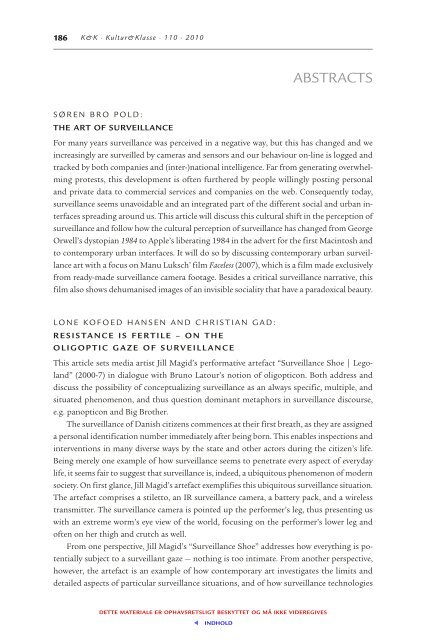K&K. Kultur og Klasse · Nr. 110 · Årgang 2010 - Aarhus University ...
K&K. Kultur og Klasse · Nr. 110 · Årgang 2010 - Aarhus University ...
K&K. Kultur og Klasse · Nr. 110 · Årgang 2010 - Aarhus University ...
Create successful ePaper yourself
Turn your PDF publications into a flip-book with our unique Google optimized e-Paper software.
186<br />
K&K <strong>·</strong> <strong>Kultur</strong>&<strong>Klasse</strong> <strong>·</strong> <strong>110</strong> <strong>·</strong> <strong>2010</strong><br />
SØREN BRO POLD:<br />
THE ART OF SURVEILLANCE<br />
For many years surveillance was perceived in a negative way, but this has changed and we<br />
increasingly are surveilled by cameras and sensors and our behaviour on-line is l<strong>og</strong>ged and<br />
tracked by both companies and (inter-)national intelligence. Far from generating overwhelming<br />
protests, this development is often furthered by people willingly posting personal<br />
and private data to commercial services and companies on the web. Consequently today,<br />
surveillance seems unavoidable and an integrated part of the different social and urban interfaces<br />
spreading around us. This article will discuss this cultural shift in the perception of<br />
surveillance and follow how the cultural perception of surveillance has changed from George<br />
Orwell’s dystopian 1984 to Apple’s liberating 1984 in the advert for the first Macintosh and<br />
to contemporary urban interfaces. It will do so by discussing contemporary urban surveillance<br />
art with a focus on Manu Luksch’ film Faceless (2007), which is a film made exclusively<br />
from ready-made surveillance camera footage. Besides a critical surveillance narrative, this<br />
film also shows dehumanised images of an invisible sociality that have a paradoxical beauty.<br />
LONE KOFOED HANSEN AND CHRISTIAN GAD:<br />
RESISTANCE IS FERTILE – ON THE<br />
OLIGOPTIC GAZE OF SURVEILLANCE<br />
This article sets media artist Jill Magid’s performative artefact “Surveillance Shoe | Legoland”<br />
(2000-7) in dial<strong>og</strong>ue with Bruno Latour’s notion of oligopticon. Both address and<br />
discuss the possibility of conceptualizing surveillance as an always specific, multiple, and<br />
situated phenomenon, and thus question dominant metaphors in surveillance discourse,<br />
e.g. panopticon and Big Brother.<br />
The surveillance of Danish citizens commences at their first breath, as they are assigned<br />
a personal identification number immediately after being born. This enables inspections and<br />
interventions in many diverse ways by the state and other actors during the citizen’s life.<br />
Being merely one example of how surveillance seems to penetrate every aspect of everyday<br />
life, it seems fair to suggest that surveillance is, indeed, a ubiquitous phenomenon of modern<br />
society. On first glance, Jill Magid’s artefact exemplifies this ubiquitous surveillance situation.<br />
The artefact comprises a stiletto, an IR surveillance camera, a battery pack, and a wireless<br />
transmitter. The surveillance camera is pointed up the performer’s leg, thus presenting us<br />
with an extreme worm’s eye view of the world, focusing on the performer’s lower leg and<br />
often on her thigh and crutch as well.<br />
From one perspective, Jill Magid’s “Surveillance Shoe” addresses how everything is potentially<br />
subject to a surveillant gaze — nothing is too intimate. From another perspective,<br />
however, the artefact is an example of how contemporary art investigates the limits and<br />
detailed aspects of particular surveillance situations, and of how surveillance tech nol<strong>og</strong>ies<br />
DETTE MATERIALE ER OPHAVSRETSLIGT BESKYTTET OG MÅ IKKE VIDEREGIVES<br />
INDHOLD<br />
ABSTRACTS








